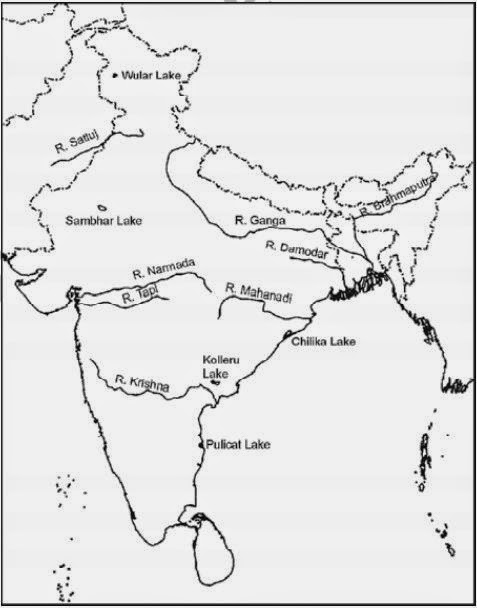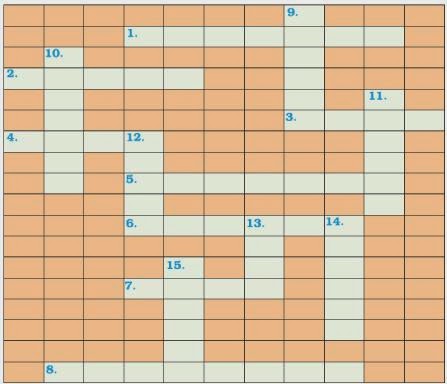GetStudySolution
Getstudysolution is an online educational platform that allows students to access quality educational services and study materials at no cost.
NCERT Solutions for Class 9 Geography chapter 3 – Drainage
Back Exercise
(i) In which of the following States is the Wular Lake located?
(a) Rajasthan
(b) Uttar Pradesh
(c) Punjab
(d) Jammu and Kashmir
► (d) Jammu and Kashmir
(ii) The river Narmada has its source at:
(a) Satpura
(b) Brahmagir
(c) Amarkantak
(d) Slopes of the Western Ghats
► (c) Amarkantak
(iii) Which one of the following lakes is a salt water lake?
(a) Sambhar
(b) Dal
(c) Wular
(d) Gobind Sagar
► (a) Sambhar
(iv) Which one of the following is the longest river of the Peninsular India?
(a) Narmada
(b) Krishna
(c) Godavari
(d) Mahanadi
► (c) Godavari
(v) Which among the following rivers flows through a rift valley?
(a) Damodar
(b) Tungabhadra
(c) Krishna
(d) Tapi
► (d) Tapi
2. Answer the following questions briefly.
(i) What is meant by a water divide? Give an example.
(ii) Which is the largest river basin in India?
(iii) Where do the rivers Indus and Ganga have their origin?
(iv) Name two headstreams of the Ganga. Where do they to form the Ganga?
(v) Why does Brahmaputra in the Tibetan part have less silt despite a longer course?
(vi) Which two peninsular rivers flow through troughs? What features do they form while entering the sea?
(vii) State some economic benefits of rivers and lakes.
Answer
(i) Any upland or a mountain separating two adjoining drainage basins is known as water divide. An example of water divide is the Western Ghats.
(ii) The Ganga river basin is the largest river basin in India.
(iii) The Indus river has its origin in Tibet near the Mansarovar Lake while the Ganga River has its origin in Gangotri Glacier in Uttaranchal.
(iv) Alaknanda and Bhagirathi are the two headstreams of the Ganga. They both meet to form the Ganga at Devprayag.
(v) The Brahmaputra river, which is known as Tsangpo in Tibet, carries a smaller volume of water and less silt as it is a cold and dry area. But once it enters India, Brahmaputra is fed by heavy rains, and it carries lot of water and silt.
(vi) The two rivers that flow through troughs are Narmada and Tapi. They form estuaries while
entering the sea.
(vii) River is very beneficial for agricultural purpose and generating hydro-electricity. It provides fisheries, inland channels for transport. Lakes like the Sambhar Lake provide edible salt. They also help develop tourism and provide recreation.
3. Below are given names of a few lakes of India. Group those under two categories - natural and created by human beings.
(a) Wular (b) Dal (c) Nainital (d) Bhimtal (e) Gobind Sagar (f) Loktak (g) Barapani (h) Chilika (i) Sambhar (j) Rana Pratap Sagar (k) Nizam Sagar (l) Pulicat (m) Nagarjuna Sagar (n) Hirakud
Answer
Natural Lakes: Wular, Dal, Nainital, Bhimtal, Chilika, Pulicat, Sambhar, Barapani, Loktak
Created by human beings: Gobind Sagar, Hirakud, Rana Pratap Sagar, Nagarjuna Sagar, Nizam Sagar
4. Discuss the significant difference between the Himalayan and the Peninsular rivers.
Answer
(a) Rajasthan
(b) Uttar Pradesh
(c) Punjab
(d) Jammu and Kashmir
► (d) Jammu and Kashmir
(ii) The river Narmada has its source at:
(a) Satpura
(b) Brahmagir
(c) Amarkantak
(d) Slopes of the Western Ghats
► (c) Amarkantak
(iii) Which one of the following lakes is a salt water lake?
(a) Sambhar
(b) Dal
(c) Wular
(d) Gobind Sagar
► (a) Sambhar
(iv) Which one of the following is the longest river of the Peninsular India?
(a) Narmada
(b) Krishna
(c) Godavari
(d) Mahanadi
► (c) Godavari
(v) Which among the following rivers flows through a rift valley?
(a) Damodar
(b) Tungabhadra
(c) Krishna
(d) Tapi
► (d) Tapi
2. Answer the following questions briefly.
(i) What is meant by a water divide? Give an example.
(ii) Which is the largest river basin in India?
(iii) Where do the rivers Indus and Ganga have their origin?
(iv) Name two headstreams of the Ganga. Where do they to form the Ganga?
(v) Why does Brahmaputra in the Tibetan part have less silt despite a longer course?
(vi) Which two peninsular rivers flow through troughs? What features do they form while entering the sea?
(vii) State some economic benefits of rivers and lakes.
Answer
(i) Any upland or a mountain separating two adjoining drainage basins is known as water divide. An example of water divide is the Western Ghats.
(ii) The Ganga river basin is the largest river basin in India.
(iii) The Indus river has its origin in Tibet near the Mansarovar Lake while the Ganga River has its origin in Gangotri Glacier in Uttaranchal.
(iv) Alaknanda and Bhagirathi are the two headstreams of the Ganga. They both meet to form the Ganga at Devprayag.
(v) The Brahmaputra river, which is known as Tsangpo in Tibet, carries a smaller volume of water and less silt as it is a cold and dry area. But once it enters India, Brahmaputra is fed by heavy rains, and it carries lot of water and silt.
(vi) The two rivers that flow through troughs are Narmada and Tapi. They form estuaries while
entering the sea.
(vii) River is very beneficial for agricultural purpose and generating hydro-electricity. It provides fisheries, inland channels for transport. Lakes like the Sambhar Lake provide edible salt. They also help develop tourism and provide recreation.
3. Below are given names of a few lakes of India. Group those under two categories - natural and created by human beings.
(a) Wular (b) Dal (c) Nainital (d) Bhimtal (e) Gobind Sagar (f) Loktak (g) Barapani (h) Chilika (i) Sambhar (j) Rana Pratap Sagar (k) Nizam Sagar (l) Pulicat (m) Nagarjuna Sagar (n) Hirakud
Natural Lakes: Wular, Dal, Nainital, Bhimtal, Chilika, Pulicat, Sambhar, Barapani, Loktak
Created by human beings: Gobind Sagar, Hirakud, Rana Pratap Sagar, Nagarjuna Sagar, Nizam Sagar
4. Discuss the significant difference between the Himalayan and the Peninsular rivers.
Answer
Himalayan Rivers
|
Peninsular Rivers
|
| Originate from Himalayas | Originate in the Western Ghats |
| These are perennial rivers. | These are seasonal rivers. |
| They receive water from rain as well as from melted snow from the lofty mountains. | These rivers are dependent upon rainfall. During the dry season, even the large rivers have reduced flow of water |
5. Compare the east-flowing and the west-flowing rivers of the Peninsular Plateau.
Answer
East Flowing Rivers
|
West Flowing Rivers
|
| Major rivers flowing eastwards: Mahanadi, Godavari, Krishna, Kaveri | Only two long rivers flow westwards: Narmada, Tapi |
| These rivers drain in the Bay of Bengal. | These rivers drain in the Arabian sea. |
| Carry greater amount of sediments, so form deltas at their mouths | Carry lesser amount of sediments, so form estuaries at their mouths |
| Greater number of tributaries | Lesser number of tributaries |
| These river flow not through very deep canals. | These rivers flow in troughs. |
6. Why are rivers important for the country’s economy?
Answer
The rivers important for the country’s economy because:
→ It is source of natural fresh water which is required for the survival of most of the animals including human.
→ The water from the rivers is used for various domestic, industrial and agricultural purposes.
→ The presence of rivers boosts trade and commerce by helping in the easy transport of goods. They are also a potential source of energy.
→ The water from rivers is used for running hydro-electric dams.
→ It is also used for navigation and transport thus, important for commercial activities.
→ It also provides fishing and great scenic and recreational value. Thus,serve as good tourist spots.
Map Skills
(i) On an outline map of India mark and label the following rivers: Ganga, Satluj, Damodar, Krishna, Narmada, Tapi, Mahanadi, and Brahmaputra.
(ii) On an outline map of India mark and label the following lakes: Chilika, Sambhar, Wular, Pulicat, Kolleru.
Answer

Page No: 25
Project/Activity
Across
1. Nagarjuna Sagar is a river valley project. Name the river?
2. The longest river of India.
3. The river which originates from a place known as Beas Kund.
4. The river which rises in the Betul district of MP and flows westwards.
5. The river which was known as the “Sorrow” if West Bengal.
6. The river on which the reservoir for Indira Gandhi canal has been built.
7. The river whose source lies near Rohtang Pass.
8. The longest river of Peninsular India.
Down
9. A tributary of Indus originating from Himachal Pradesh.
10. The river flowing through fault, drains into the Arabian Sea.
11. A river of South India, which receives rain water both in summer and winter.
12. A river which flows through Ladakh, Gilgit and Pakistan.
13. A important river of the Indian desert.
14. The river which joins Chenab in Pakistan.
15. A river which rises at Yamunotri glacier.

Answer

In-Text Questions
Page 17
Question 1. Which river has the largest basin in India?
Answer The largest basin in India is of the Ganga river with a drainage area of 8,62,769 sq km.
Page 22
Question 1. Find out the name of the biggest waterfall in India.
Answer The highest waterfall in India is on the Varahi river in Shimoga district of Karnataka. The name of the waterfall is Kunchikal Falls and its height is 455 metres (1,493 ft).
Page 23
Question 1. Make a list of natural and artificial lakes with the help of the atlas.
Answer
| Natural Lake | Artificial lake |
| (a) Wular lake | (a) Gobind sagar |
| (b) Dal lake | (b) Rana Pratap sagar |
| (c) Nainital lake | (c) Nizam sagar |
| (d) Bhimtal lake | (d) Nagarjuna sagar |
| (e) Loktok lake | (e) Hirakud |
| (f) Barapani lake | |
| (g) Chilka lake | |
| (h) Sambhar lake | |
| (i) Pulicat lake | |
| (j) Kolleru lake | |
| (k) Vembanad lake |